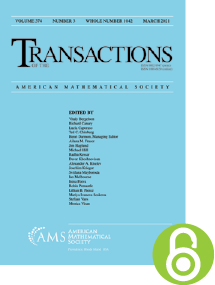Decomposition numbers for finite Coxeter groups and generalised non-crossing partitions
HTML articles powered by AMS MathViewer
- by C. Krattenthaler and T. W. Müller PDF
- Trans. Amer. Math. Soc. 362 (2010), 2723-2787 Request permission
Abstract:
Given a finite irreducible Coxeter group $W$, a positive integer $d$, and types $T_1,T_2,\dots ,T_d$ (in the sense of the classification of finite Coxeter groups), we compute the number of decompositions $c=\sigma _1\sigma _2\cdots \sigma _d$ of a Coxeter element $c$ of $W$, such that $\sigma _i$ is a Coxeter element in a subgroup of type $T_i$ in $W$, $i=1,2,\dots ,d$, and such that the factorisation is “minimal” in the sense that the sum of the ranks of the $T_i$’s, $i=1,2,\dots ,d$, equals the rank of $W$. For the exceptional types, these decomposition numbers have been computed by the first author in [“Topics in Discrete Mathematics,” M. Klazar et al. (eds.), Springer–Verlag, Berlin, New York, 2006, pp. 93–126] and [Séminaire Lotharingien Combin. 54 (2006), Article B54l]. The type $A_n$ decomposition numbers have been computed by Goulden and Jackson in [Europ. J. Combin. 13 (1992), 357–365], albeit using a somewhat different language. We explain how to extract the type $B_n$ decomposition numbers from results of Bóna, Bousquet, Labelle and Leroux [Adv. Appl. Math. 24 (2000), 22–56] on map enumeration. Our formula for the type $D_n$ decomposition numbers is new. These results are then used to determine, for a fixed positive integer $l$ and fixed integers $r_1\le r_2\le \dots \le r_l$, the number of multi-chains $\pi _1\le \pi _2\le \dots \le \pi _l$ in Armstrong’s generalised non-crossing partitions poset, where the poset rank of $\pi _i$ equals $r_i$ and where the “block structure” of $\pi _1$ is prescribed. We demonstrate that this result implies all known enumerative results on ordinary and generalised non-crossing partitions via appropriate summations. Surprisingly, this result on multi-chain enumeration is new even for the original non-crossing partitions of Kreweras. Moreover, the result allows one to solve the problem of rank-selected chain enumeration in the type $D_n$ generalised non-crossing partitions poset, which, in turn, leads to a proof of Armstrong’s $F=M$ Conjecture in type $D_n$, thus completing a computational proof of the $F=M$ Conjecture for all types. It also allows one to address another conjecture of Armstrong on maximal intervals containing a random multi-chain in the generalised non-crossing partitions poset.References
Additional Information
- C. Krattenthaler
- Affiliation: Fakultät für Mathematik, Universität Wien, Nordbergstraße 15, A-1090 Vienna, Austria
- MR Author ID: 106265
- T. W. Müller
- Affiliation: School of Mathematical Sciences, Queen Mary & Westfield College, University of London, Mile End Road, London E1 4NS, United Kingdom
- Received by editor(s): June 30, 2008
- Received by editor(s) in revised form: December 10, 2008
- Published electronically: December 17, 2009
- Additional Notes: The first author’s research was partially supported by the Austrian Science Foundation FWF, grant S9607-N13, in the framework of the National Research Network “Analytic Combinatorics and Probabilistic Number Theory”
- © Copyright 2009
American Mathematical Society
The copyright for this article reverts to public domain 28 years after publication. - Journal: Trans. Amer. Math. Soc. 362 (2010), 2723-2787
- MSC (2000): Primary 05E15; Secondary 05A05, 05A10, 05A15, 05A18, 06A07, 20F55, 33C05
- DOI: https://doi.org/10.1090/S0002-9947-09-04981-2
- MathSciNet review: 2584617


